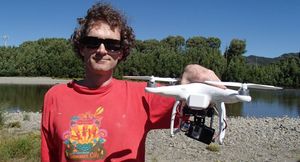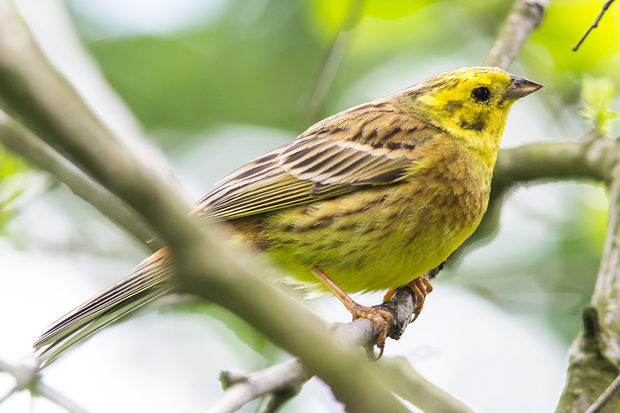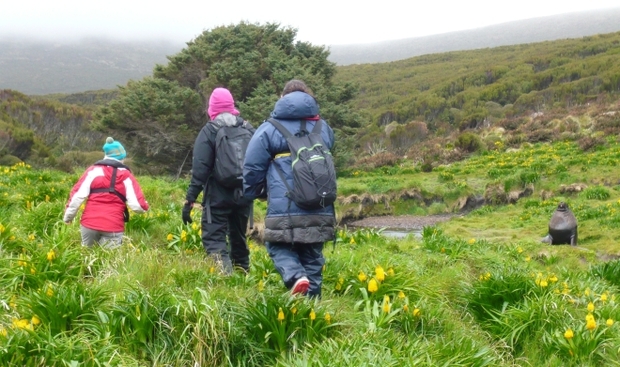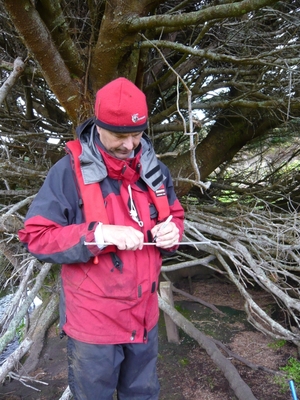Our Changing World for Thursday 19 December 2013
UAV and Aerial Monitoring of Toxic Algae Blooms

PhD student Mark Heath at the Hutt River, holding a stone that is covered in green algae, light brown muddy-looking diatoms, and several dark brown blobs of toxic algae (images: A. Ballance)
 In the past 8 years, 13 dogs have died as a result of eating toxic algae in the Hutt River. The toxic algae are cyanobacteria or blue-green algae and they form big black mats in the river after a period of hot dry summer weather. The toxic algae has a distinctive earthy smell, and, as its name suggests, is very toxic.
In the past 8 years, 13 dogs have died as a result of eating toxic algae in the Hutt River. The toxic algae are cyanobacteria or blue-green algae and they form big black mats in the river after a period of hot dry summer weather. The toxic algae has a distinctive earthy smell, and, as its name suggests, is very toxic.
Greater Wellington Council regularly test the river waters for the presence of the algae, and post information on their website and on notices along the river.
PhD student Mark Heath from the School of Biological Sciences at Victoria University of Wellington has been investigating the algae, and wonders if it might be possible to use a small unmanned aerial vehicle to film the river from the air as a quick way of monitoring the size of algal blooms. He is collaborating with Greater Wellington, the Cawthron Institute and the School of Engineering and Computer Science at Victoria University in a trial being run by summer student Sonja Hempel, and quadcopter pilot Jonathan Olds (pictured above).
Parkinson’s Disease and Musical Metronomes

From left to right: Tara Martin, John Chitty and Chris Chitty (image: R Beran)
Approximately 1 in 500 people have Parkinson’s disease, a neurodegenerative condition which affects things like coordination and motor skills. While Parkinson’s can be treated, it cannot be cured and it is a progressive condition which can take many years to develop.
Many people with Parkinson’s disease shuffle their feet, but for some, their feet will simply stop moving, and then “freeze”. The forward momentum of walking then causes them to fall.
Physiotherapist Tara Martin from On the Go has developed a program called Cued Up which uses the ticking of a musical metronome to help stop these patients from “freezing”. She is completing a Masters degree at the University of Otago and the New Zealand Brain Research Institute.
Metronomes are something that musicians use to keep to set the tempo and keep time in a piece of music. By using the evenly paced audio cues, as well as using visual cues, patients with Parkinson’s disease can be trained to take bigger steps and therefore stop freezing as frequently, and therefore stop falling so badly.
John Chitty has been using the program and finds that it has been invaluable. Ruth Beran went to his home to see him do some of the exercises, and also spoke with his wife Chris Chitty.
Semi-Automated Colour Analysis

The most popular colours for national flags are red, white, green and dark blue. The national flag of Qatar (left) is the only flag with the colour purple, and very few flags have black, like the flag of Germany (right).
Adrian Clark and Christoph Bartneck from the HIT Lab at the University of Canterbury have developed a software tool that can semi-automatically analyse colour in large sets of graphics.
The Human Interface Technology Laboratory or HITLabNZ at the University of Canterbury develops technology to help improve human computer interaction. Christoph Bartneck is interested in colour, as it’s used in various logos and brands, for example. In particular he’s been wondering about the possibility of fully automating the analysis of colour by computer. To do that he enlisted the help of post-doctoral researcher Adrian Clark, who works in the field of computer vision.
As Adrian and Christoph tell Alison Ballance, they began working on the problem using a rather unusual data set – 194 national flags – before analysing the logos of some large financial institutions, and they soon discovered that it was not possible to fully automate the process, as computers are not as clever as people at recognising colour.
They eventually settled on 12 colours, and found that the most popular colours were, in descending order, red, white, green and dark blue, making up 75% of the surface in all flags. The most popular two-colour combination was red and blue.
A correlation between economic status of countries and the colour of their flags showed that white was strongly correlated with economically strong countries, while green was associated with poorer countries, especially in Africa.
You can read about their results in the paper ‘Semi-automatic color analysis for brand logos’.
Yellowhammer Dialects

Yellowhammer song is thought to have inspired the first few notes of Beethoven’s Fifth Symphony, and if you’re out and about this summer, you could help record the birds for an international ornithology project investigating their dialects.
Acclimatisation Societies introduced yellowhammers (Emberiza citrinella) in New Zealand during the 1870s, initially in the hope that they would feed on insects. The colourful birds spread quickly, but soon became a nuisance for grain growers as they preferred to feed on seeds. Today, yellowhammers are common in open country throughout much of New Zealand.
The Yellowhammer Dialects project began in the Czech Republic, originally exploring the differences in birdsong between regions. Now the project has expanded to the UK, where yellowhammers are in serious decline, and New Zealand to study the cultural evolution of yellowhammer song as the birds moved from their country of origin to their new home. By tracking how the birds’ dialects spread and changed, the ornithologists hope to answer broader questions about what happens to bird song during an invasion of new territory.
One of the ornithologists, Pavel Pipek is in New Zealand at the moment to collect as many recordings as he can. But he hopes New Zealanders will join the citizen science project to gather recordings from all regions.
You can find out more about yellowhammers and their song, how you can use your mobile phone or camera to record them, and even an app to help you do so. And here you can listen to different yellowhammer dialects.
Future Scientists
Nine secondary school students won awards at the Genesis Energy Realise the Dream event, the National School Science and Technology Awards, which was held last week.
Tom Morgan, of Marlborough Boys College, won the supreme award, which includes a $7,000 cash scholarship and a trip to the European Union Young Scientist Competition in Warsaw next year, for his study of UV exposure and Vitamin D production in oyster mushrooms.
Tom grew the mushrooms in the dark (in a cupboard at his family home) and then exposed them to UV light for varying periods of time before testing their concentration of Vitamin D. He developed inexpensive and simple techniques that use equipment available in many laboratories, and the research highlights the potential for addressing Vitamin D deficiency, which is linked to osteoporosis.
You can find details about the competition and all other winners here.
The World's Loneliest Christmas Tree

The world's loneliest tree, a Sitka spruce, stands among flowering megaherbs on New Zealand's southern-most subantarctic island. (images: V Meduna)
Campbell Island is New Zealand’s southern-most subantarctic island, some 700 km south of Bluff. It is home to some of the cloudiest weather in the subantarctic region, with fewer than 600 hours of bright sunshine and only 40 days per year without rain.
 The island is also home to an unruly Sitka spruce, known as the world’s loneliest tree in the Guinness Book of World Records. Its nearest taxonomic cousins live far away in the Northern Hemisphere, and there are no other introduced trees on Campbell Island. But despite being so out of place and in such a rugged climate, the tree is thriving, except that it has grown into a shape that is more akin to a giant cauliflower than a tree.
The island is also home to an unruly Sitka spruce, known as the world’s loneliest tree in the Guinness Book of World Records. Its nearest taxonomic cousins live far away in the Northern Hemisphere, and there are no other introduced trees on Campbell Island. But despite being so out of place and in such a rugged climate, the tree is thriving, except that it has grown into a shape that is more akin to a giant cauliflower than a tree.
The spruce is sometimes also referred to as the Ranfurly’s tree because it is thought that Lord Ranfurly, governor general of New Zealand at the turn of the 20th century, planted it sometime between 1901 and 1907. During the first leg of the Spirit of Mawson expedition earlier this month, Jonathan Palmer (left), who is part of the University of New South Wales' palaeoclimate consortium, took a core sample from the tree in the hope that its tree rings would reveal climate information for the past century. However, he found that even the thickest branches are only about 46 years old, which suggests that the spruce may well have once grown in its more common straight shape, but that its main trunk ended up as a Christmas tree a few decades ago, during the period when the (now automated) meteorological station on Campbell Island was still staffed year round.
Get Off The Grass lecture
University of Auckland physicist Shaun Hendy presents a lecture about how innovation drives the economy